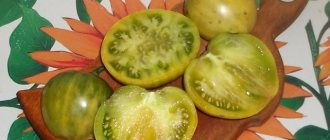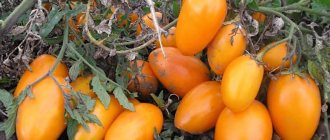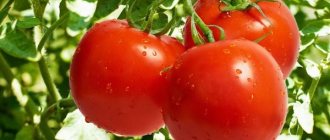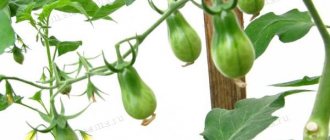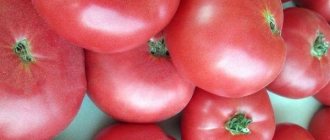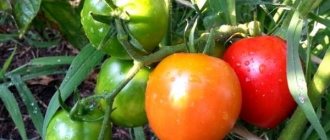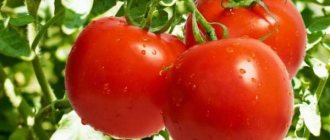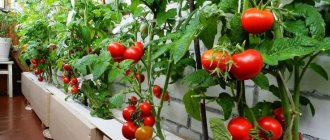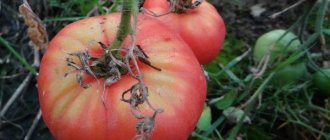The warm season in the Urals passes quickly, and favorable conditions for growing tomatoes last up to a hundred days. Accordingly, in order to get a high-quality harvest, you have to adapt to the existing climate. Tomatoes love warmth and light, so where there are few of them, it is better to grow these vegetables in greenhouses. How successful this will be depends on both proper care and the chosen variety.
Tomatoes for a greenhouse in the Urals: how to choose varieties
In order not to make a mistake with your choice, you need to find out in advance exactly which specific varieties of tomatoes are appropriate to plant in the Urals in a garden bed in a greenhouse. Tomatoes intended for the Ural regions must have certain characteristics that satisfy a number of important requirements:
- Have the ability to easily tolerate sudden changes in temperature. During the day, the greenhouse seriously overheats, sometimes to critical levels. At night, cooling inevitably occurs, which creates a stressful situation for the plants. Not every tomato variety is capable of setting fruit in such circumstances.
- Have low susceptibility to most typical diseases of nightshade crops. In a closed greenhouse space, optimal and most favorable conditions are created for the development of pathogenic organisms. Therefore, tomatoes grown in a greenhouse must have excellent immunity.
- It’s early (within 100 days) and together to give away the harvest. The bulk of the fruit should be collected before the onset of disease. In this way, you can avoid infection with the most common fungal pathology - late blight, which is especially important in the difficult climate of the Urals.
- Characterized by high yields so that all costs are recouped.
- It can withstand transportation well and has high shelf life.
As a rule, on the packaging of store-bought seeds there is always an indication of the possibility of growing specifically in the Urals. Such tomatoes are usually hybrid, zoned for the local difficult climate.
Growing process
In the conditions of the Urals, the growing season lasts 3-4 months. It is not recommended to transplant seedlings into a greenhouse before May. Plants that are 30 cm high and have a strong trunk are least affected by overheating and lack of light. In addition, they manage to form their root system larger than the pot. If the optimal height is considered to be 30 cm, then growing seedlings will take 2-2.5 months.
Thus, the process of planting seeds for seedlings should occur in early March. During planting, it is necessary to stock up on the number of bushes. In addition, you should not plant weakened or disease-affected shoots. They will still not be able to recover; other plants will not be able to take their place.
Tomatoes for a greenhouse in the Urals: the best early varieties
It is most logical, when selecting tomatoes acceptable for the Urals with the condition of placing them in a greenhouse, to focus on the earliest ripening ones, the best varieties of which are recognized as:
Krakowiak
Tomatoes for a greenhouse in the Urals.
Variety Krakowiak Super-early ripening (78-83 days), standard-shaped (no gartering or pinching required), small-leaved, determinate variety no more than half a meter high. Tomatoes of excellent taste with noticeable sourness, slightly flattened with barely noticeable ribbing, for salad purposes, weighing about 70-80 g. From 1 m2 it is possible to gain up to 3-4 kg.
Aphrodite F1
Tomatoes for the Urals for greenhouses.
Aphrodite F1 Dwarf bush (up to 0.35-0.55 m) with limited growth and medium-sized leaves. It branches quickly, therefore requiring attachment to supporting structures and the formation of a crown (ideal for the Urals). An early salad hybrid (75-80 days) with good taste, rather large (110-115 g), traditionally red dense fruits, characterized by excellent keeping quality.
Ultra early ripening
Tomato, variety Ultra early ripening
The plant is compact and low-growing (0.55-0.7 m), yielding a harvest 100-110 days later (up to 6.5-7 kg is harvested from 1 m2). A hybrid, non-prunable form with a friendly harvest of very tasty, glossy, smooth tomatoes of universal use, weighing 60-80 g (sometimes up to 100 g). To prevent heavy brushes from breaking off, they need to be fixed to a trellis or support installed in the greenhouse.
Alpha
Early tomatoes for a greenhouse in the Urals.
Variety Alpha Superdeterminate tomato variety of standard type (growth about 0.4-0.5 m), very early ripening (87-96 days) with potato-type leaf blades of medium size and regular dark green color. It is permissible to sow directly into the greenhouse, bypassing the seedling stage. Ripe tomatoes are smooth and elegant, weighing approximately 80-90 g, more suitable for fresh consumption. Marketable yield when maintaining agricultural technology is 6.2 kg/m2.
Planting in open ground
Planting tomatoes in open ground
When to plant tomatoes in the Urals in open ground? Not earlier than when the air warms up to 12°C at night, and up to 25°C during the day. In the south of the region, such weather occurs around mid-May, and not always, and in the north - in mid-June.
Note! You can understand that the seedlings are ready for planting in open ground by making sure that they have at least 6 leaves. The height of the bushes should not exceed 30 cm, optimally 20-25 cm. The stems should be strong and the leaves should be green.
When to plant seedlings in a greenhouse
If heating is available, seedlings are planted in a greenhouse in the Urals at the end of April. Planting in a cold greenhouse is carried out in early May. It should not be below 20°C during the day and 10°C at night. The soil temperature at a depth of 10 cm should not be lower than 12°C.
Important! Be sure to take into account the age of the seedlings. It is advisable to plant plants that are 50-60 days old. Seedlings must have at least 8 leaves and 2 inflorescences.
Planting seedlings in a greenhouse
If the greenhouse is covered with polyethylene, it is better to cover it with a double layer of film with a small gap between them of about 3-4 cm. It is also worth replacing the top layer monthly, otherwise it will become deformed.
- Soil preparation. The soil is dug up halfway, then it should be treated with organic fertilizers. Many summer residents usually use humus and ash. Further planting of seedlings depends on the tomato variety. The tall species is planted in 2 rows, the distance between which is 70-80 cm. Holes are made (about 50 cm from each other) 5-10 cm deep. Then they are watered with warm water. Parallel and staggered circuits are used. The width of the passage should be 90-100 cm.
- The landing itself. Carefully, so as not to damage the roots, the seedlings are removed from the molds, lowered into the holes, tied to the top of the greenhouse and watered. The next watering is carried out in a week.
For your information! What to do if the tomato seedlings are overgrown? You need to cut off all the side leaves to the top and bury the stem. One crown should remain above the surface of the earth.
Yield tomatoes for a greenhouse in the Urals
Experience shows that even in not the most favorable climate it is possible to get a very decent tomato harvest. It is enough just to wisely choose the most productive and prolific varieties of tomatoes that are optimally suited for the Urals with localization in a greenhouse. Suitable:
Pudovik
Yield tomatoes for a greenhouse in the Urals.
Variety Pudovik Requiring formation (with the removal of lateral shoots) and mandatory tying to pins or stakes, indeterminate bush, more than 1-1.5 m in height, with large green leaves, mid-ripening (110-115 days). Heart-shaped, raspberry-red, brightly colored, juicy, fleshy and tasty, tomatoes are recommended both for salad consumption and for processing. Productivity - 15.5 kg/m2. In the State Register, the declared weight of one fruit is about 290 g, but in reality (especially in a greenhouse) it is much more - 0.8-1 kg.
Pink Elephant
Tomato variety Pink Elephant
Not too leafy, mid-early (112-115 days), growing up to 2 m (although considered semi-determinate) bush. Deep pink tomatoes, distinguished by excellent taste characteristics, large (280 g in weight), fleshy, flat-round in shape with a strongly ribbed base and notched top. Productivity - up to 8.2 kg/m2.
Pink icicle
High-yielding tomato variety Pink Icicle
Highly productive, ripening quite early (105-115 days), indeterminate, forming a large number of flower and fruit clusters (up to a dozen), tall (up to 1.8 m) variety, suitable for the Urals. Ripe tomatoes have a delicate salmon-pink hue, living up to their name, elongated shape, and excellent sweetish taste. It is often possible to collect up to 10 kg per plant, 110 g is the weight of one tomato.
Titanic F1
Tomato Titanic F1
Large-fruited (about 200 g), medium-term (110-113 days) from sowing to harvest, medium-sized, indeterminate hybrid, originally intended for greenhouses, as well as other protective shelters. A ripe fruit of a rich and familiar tomato red color, excellent taste, mainly used in salads in an unprocessed fresh form. The declared yield according to the State Register is 10 kg per plant.
Samara F1
Tomatoes for a greenhouse in the Urals.
Samara F1 Tall (2 m), medium branching and foliage, creeping, indeterminate, early ripening (94-118 days) variety. Ripe tomatoes are traditionally red, shiny, flat at the base, not prone to cracking, not too large (70-85 g), but on a bush (even in the Urals) there can be up to 9.7 kg/m2 per season. The taste is good.
Tomatoes for the Urals for greenhouses: low-growing varieties
A guaranteed harvest, almost regardless of the weather, can be obtained from short and dwarf varieties of tomatoes, zoned for the Urals and suitable for planting in greenhouses:
Amber 530
Amber tomato 530
Yellow-fruited, low-growing 0.4 m, determinate, tomato that does not need to remove stepsons, but requires garter. Marketable yield is 2-2.7 kg/m2. The ripening period is 91-95 days. The fruits are usually flat-rounded, weighing about 80-85 g (often 120-150 g), good taste, eaten fresh.
Snubnosik
Tomato Snubnosik
Low (not higher than 0.5 m), super-determinate, bush with simple, medium-sized leaf blades of delicate light green shades. Very beautiful and attractive to look at, reddened ripe tomatoes are heart-shaped with a slightly blunt tip and ripen no later than 100-110 days. One fruit weighs about 150-200 g; its taste is rated “good.” From 1 m2 you can get up to 6.5 kg. You can plant not only in greenhouses, but also directly into the ground (even in the Urals).
Siberian Troika
Standard tomato variety Siberian Troika
Standard, powerful, stable, well-leafed, compact and low bush (0.5-0.6 m) with limited height growth (determinant). The variety is mid-ripening (up to 115 days), high-yielding (6 kg/m2). The tomatoes are cylindrical with a slightly elongated nose, weigh on average 200 g, and have an excellent sweetish taste.
Explosion
Tomato variety Explosion
Universal purpose, pleasantly early ripening (93-98 days), spreading, very low (0.5-0.6 m) variety of determinant type of development (steps moderately). Red, fully ripe tomatoes with pleasant roundness, weighing approximately 90 g. From 1 m2 it will be about 4-4.1 kg.
Doll Masha
Tomato Doll Masha
Limited growth, a determinate plant that needs to be moderately pinched in the greenhouse, stretching only up to 0.7 m. The hybrid bears fruit abundantly (8 kg/m2) and ripens well. The tomatoes are large (200-260 g) with weak ribbing, a beautiful even pink color and excellent taste (rated by expert tasters as the highest score - 5).
How to properly transplant tomato seedlings into a polycarbonate greenhouse
If the soil in the greenhouse is dry, it must be watered with warm water in advance. And when the water is absorbed, loosen the beds. The seedlings are also watered abundantly on the eve of planting. The earthen ball of seedlings should be moderately moist at the time of planting.
The placement of tomatoes also plays an important role. When plantings are dense, plants become sick more often, develop worse, and the yield decreases. The optimal arrangement of tomatoes is a checkerboard pattern. The distance between low-growing varieties is 30x40 cm. Mid-season (determinant) varieties are best planted with a distance between plants of 50 cm. Indeterminate varieties (tall) are planted in one or two rows, the distance between tomatoes is 50-80 cm, between rows 80-100 cm.
Before planting, we remove the seven-lobed and lower leaves from the plant, leaving 5 true leaves on the plant.
At the site of the proposed planting, we dig holes 20-25 cm deep.
Pour about a liter of warm water into the hole, mix the water with the soil to form a pasty slurry.
By transshipment, we remove the plant from the seedling container along with a lump of earth. At the same time, the lump should not fall apart from dryness. We place the seedlings with a lump of earth vertically in the hole. If the seedlings were grown in peat pots, place the plant along with the pot in the prepared hole. Fill the hole with soil and lightly compact the soil with your hands.
Then we water the planted plant with a solution of Fitosporin. Such watering will allow the plant to quickly recover from stress after transplantation. You can tie up the seedlings right away. But if the seedlings are strong and short, then the garter can be postponed for ten days.
Sometimes, if agricultural practices are violated, it is necessary to plant very elongated seedlings. In this case, the seedlings are planted in a “lying” position. Before transplanting, remove all the lower leaves of the tomato, leaving the top 5 leaves.
Then a groove (groove) 20-25 cm deep and the same length is dug in the ground. Pour water into it and mix it with soil to make a liquid paste. We place the plant in this slurry, with the earthen lump to the south. We slightly lift the upper part, leave it at the top, and bury the lower part with earth, compacting it slightly. Then water the planting with warm water. After a few days, the top of the plant will straighten, and additional roots will form in the underground part, the plant will adapt faster and will continue to develop well.
Plantings can be mulched, which will allow less moisture to evaporate, weeds will not grow and an earthen crust will form after watering.
Tomatoes for the Urals for greenhouses: large-fruited
Huge meaty tomatoes are the cherished dream of any passionate vegetable grower. It is believed that the sweetest, most delicious and largest tomatoes can grow only under the hot southern sun. However, thanks to the tireless efforts of breeders, outstanding large-fruited tomato varieties have appeared, reaching maximum dimensions and suitable for the Urals (but suitable only for greenhouses):
Biysk rozan
Large-fruited tomatoes for the Urals for greenhouses.
Variety Biysky Rozan Self-limiting in growth, but at the same time requiring breaking off of excess stepsons and gartering, not too tall (0.75-1.1 m) plant. High-yielding tomato (4.6 kg/m2), for greenhouses, mid-early (110 days) with fleshy, voluminous, excellent taste, pink fruits, the weight of which, according to official data, is about 250 g, but in reality 0.5-1 kg ( and even 1.2 kg).
Berdsky large
Tomatoes for a greenhouse in the Urals.
variety Berdsky large Tomato variety, characterized by large fruit (0.7 kg) and yield (10-12 kg per m2). The bush is small (up to 1 m even in a greenhouse), semi-determinate (a garter is required, pinching up to the lower brush). Ripe tomatoes are pink-skinned, fleshy and sugary at the break, very tasty, ideally combining tomato sourness and sweetness. The ripening period is 105-110 days.
Abakan pink
Abakan pink tomato
An interesting salad variety for greenhouses with large (up to 0.5 kg) pink, flat-round or heart-shaped, good-tasting fruits that ripen in 110-120 days. Rarely exceeding 1.35-1.5 m in height, determinate (only a classic garter is needed), productive (4 kg/m2) bush.
Sugar Nastasya
Variety Sugar Nastasya
One of the most productive (from 1 m2 you can get up to 9-11 kg), medium-sized (1.5 m) indeterminate tomato for greenhouses, medium-late (120-130 days) ripening period, suitable for use in the Urals. An exclusively salad variety with large (0.25-0.3 or more), amazingly tasty, honey-like, low-seeded, red fruits.
Lemon giant
Large-fruited tomato variety Lemon Giant
Stable yield (6.1-6.7 kg/m2), salad, mid-season (109 days), indeterminate type tomato, stretching up to 1.5-2 m, requiring shaping and fixation to a support. The fruits are original yellow-lemon in color, very large (0.35-0.38 kg, sometimes up to 0.9 kg). The taste is excellent (five stars).
Tomato care
Within 4-6 days after transplanting the tomatoes, they take root and no action needs to be taken with them. Then watering is carried out as the soil dries out. Overfilling is unacceptable, as it leads to the development of fungal diseases. Plants are irrigated not often, but abundantly.
To prevent drops from falling on the leaves when watering, you can use a watering can without a nozzle or drip irrigation.
Drip irrigation allows you to reduce the likelihood of plants being affected by diseases, since the water with such irrigation penetrates directly to the roots without touching the leaves.
Before the tomatoes bloom, watering with a watering can is carried out with a break of 5 days. A bucket of settled warm water is consumed per meter of area. Plants are irrigated directly under the roots, without touching the leaves and stem.
5-6 days after planting, the soil is loosened or backfilled (if a depression was made during planting), this helps improve the passage of air to the roots.
When fruiting begins, watering is reduced, as this can lead to cracking of the fruit and loss of its sugar content.
After each watering, the soil under the tomatoes is slightly loosened. Weeds are removed as they appear.
After watering and loosening, the top of the soil is sprinkled with a thin layer of dry soil.
2 weeks after planting the seedlings, the first feeding of tomatoes is carried out. For this purpose, complex mineral fertilizer (containing potassium, nitrogen and phosphorus) and organic matter is used. Fertilizing is carried out after watering the plants.
- The following fertilizer is used: 1 tablespoon of nitrophoska and 0.5 liters of mullein infusion per bucket of water. 1 liter of fertilizer is consumed per plant. Instead of mullein, you can use an infusion of chicken manure.
- During the period of fruit filling, a second feeding is carried out. In a bucket of warm water, dilute 20 grams of potassium salt, 10 grams of superphosphate, 10 grams of urea, 3 grams of potassium permanganate and 2 grams of copper sulfate.
- The third feeding is carried out before the fruit begins to ripen. For processing, a mixture of 30 grams of superphosphate, 20 grams of urea, 20 grams of potassium chloride, 10 grams of slaked lime, 2 grams of copper sulfate per bucket of water is prepared.
- Mineral fertilizers can be alternated with organic ones. When watering, you can add an infusion of weeds or nettles to the water.
To pollinate flowers in the daytime, the bushes are slightly shaken. The air in the greenhouse is dry during the day, and pollen scatters to other flowers, pollinating them.
Insects can also help pollinate tomatoes. To attract them to the greenhouse, doors and windows are opened, containers with sugar syrup, compote or kvass are placed next to the plants.
When the plants reach a height of 30 centimeters, pinching is carried out. On the bushes, the shoots and leaves from below are removed. This promotes oxygen access to developing fruits and the root system of plants.
When growing bushes in 2 shoots, the strongest stepson from below is left, and the others are removed. This procedure allows you to redirect the tomato's forces to the formation of flower clusters and increases yield. Many low-growing early-ripening and ultra-early varieties do not require pinching.
Grown tall plants or varieties with thin stems are tied to supports or trellises. The garter twine should be soft and not pull on the plants.
To prevent diseases, plants are sprayed twice a month with a solution of Bordeaux mixture, biological products or folk remedies. Irrigation is carried out in cloudy weather or in the evening and always after watering the plants.
Tomato varieties for greenhouses in the Urals, resistant to late blight
Among the best tomatoes, relatively immune to late blight (everyone gets sick, but to varying degrees), suitable for the specific conditions of greenhouses and suitable for growing in the cold Urals, the following varieties can be noted:
Rocket
Variety Rocket
Compact, sparsely leafed, small in size (0.4-0.6 m), determinate variety, allowing dense planting in greenhouses. The fruits are of good taste (score 3.8-4), with a retracted tip, red-scarlet, smooth, weighing about 34-58 g. Ideal for preservation in its entirety. The crop ripens en masse 122-129 days after sowing. Up to 9.5-10 kg/m2 - actual yield.
Semko 98 F1
Semko 98 F1
Yields after 85-120 days, early ripening, determinate, but not standard, semi-spreading, weakly branched and sparsely leafy, low (0.5-0.55 m) tomato with ordinary grayish-green leaves. In the Urals, about 3-6 kg of small (44-94 g), red, ripening, good-tasting fruits will be born per 1 m2.
Benito F1
Tomato Benito F1
Medium early (95-113 days), determinate, generously productive (5-6 kg/m2), fairly low-growing (not exceeding 0.5-0.7 m), strong, standard bush for greenhouses with large green foliage. No need for stepsoning. Ripe tomatoes weigh 40-70 g (sometimes up to 100 g), elongated, in the form of a small plum, excellent taste, regular red color.
De Barao
Tomato De Barao
A widely known and widespread indeterminate tomato variety, easily growing over 1.8-2.2 m (in a greenhouse and more than 3 m), voluminous and spreading, requiring constant pinching and a powerful garter. Universal purpose, reaching commercial ripeness quite late (115-120 days), with a declared yield of 5-6 kg/m2. The fruits are traditionally red, not too large (about 30 g), slightly elongated, plum-shaped, of excellent taste.
Verlioka F1
Tomato Verlioka F1
An early ripening (95-105 days) hybrid form that pleases with high (at least 4.5-5 kg per plant) yields in almost any weather, even in the Urals. Medium-sized (up to 1.5 m), semi-determinate, sparsely leafy tomato with densely spaced, picturesquely shiny, juicy red bright fruits (weight ranging from 90-100 g), with a pleasant slightly sweetish taste. Keeping quality is high, has no tendency to crack, and is transportable.
Alaska
Tomato Alaska
Determinate, beautiful and neat, low (0.5-0.7 m) bush, growing without formation in greenhouses. Red-colored, good-tasting fruits (85-94 g in weight) are ready for harvesting after 90-95 days. Exclusively salad consumption. From 1 m2 - about 9-11 kg.
Growing seedlings from seeds
How to grow tomato seedlings for planting in a greenhouse? Seeds for growing can be bought in a special store. They need to be placed in a container with a 5% solution of ordinary table salt. Large and strong seeds settle at the bottom, while lower quality seeds float to the surface. The drowned ones need to be taken out and dried slightly. The material prepared for planting should be hardened to avoid some diseases. This is done by dropping the seeds into a glass of water in which potassium permanganate is dissolved at the rate of 1 g per 100 ml of water. After 10 minutes, the seeds are removed from the water, washed thoroughly, and dried a little.
Before sowing tomato seeds, they need to be soaked for 48 hours in warm water. After this, they should be kept for three days at a temperature of about minus 2-3°C in the freezer compartment of the refrigerator. This hardening gives the plant immunity to low temperatures, which are not uncommon in the Urals. Such plants exhibit increased growth of the root system. Seeds hardened in this way are planted in boxes with a mixture of 3 parts soil from the garden and 2 parts sawdust. For each bucket of the mixture, add 0.5 liters of ash and 3 matchboxes of superphosphate. All ingredients are mixed well.
Tomatoes for a greenhouse in the Urals: sweet varieties
Among the huge variety of varieties, gourmets can choose the most pleasant-tasting and sweet tomatoes, intended for greenhouses and fully ripening in the Urals:
Fairy gift
Tomato Fairy's Gift
For pickling, salad and canned purposes, determinate, orange-fruited, high-yielding (9.3 kg/m2), early (93-95 days) ripening tomato for greenhouses. Fixation to the support and shaping are required. The fruits have a specific gravity of 110-115 g, a beautiful heart-shaped shape and excellent taste with pronounced sweetness.
Superbomb
Tomatoes for a greenhouse in the Urals.
Variety Superbomb High-yielding (up to 7 kg per bush), compact and not too tall (0.8-1.5 m), determinate, ripening in the middle period (110-115 days). Tomatoes, covered with a delicate pink-red skin, weigh on average 160 g, but 300-600 g are not uncommon. The taste is at the highest level.
Barmaley
Tomato Barmaley
Determinate, pink-fruited hybrid of ultra-early ripening (98 days when planted in greenhouses). Attractively looking, slightly flattened, pink, moderately ribbed fruits (up to 200 g in weight) have a pleasant, pronounced sweetish taste.
Malachite Box
Malachite box
A tall (1.5-2 m) indeterminate plant that must be formed and tied up. Salad fruits are eaten immediately fresh, they ripen medium early (111-115 days), the usual yield is up to 15.1 kg/m2. Ripe, large (250-300 g), very beautiful tomatoes are extremely unusually colored (green with a pronounced yellow tint) and have emerald green flesh and an unusual sweet-melon taste (they have time to fully ripen and gain sweetness even in the Urals).
Elton John
Elton John f1
Standard, mid-ripening (107-116 days), low (0.45-0.5 m) plant with small dark green leaves, growing well in the Urals. Ripe tomatoes are yellow-skinned, weighing between 100-150 g, without sourness and very sweet (high carotene content). In a greenhouse with 1 m2 - 9 kg.
Pink honey
Variety Pink honey
Modest (up to 0.7 m) in size, determinate bush with large fruits weighing on average 160-200 g (the weight is often over 1.5 kg). Tomatoes with a large number of internal chambers, juicy, fleshy-dense, thin-skinned, with pronounced deep ribbing, pink in color and a pleasant honey taste. The yield declared by the State Register for greenhouses is 3.8-4 kg/m2, but in fact it is much higher.
Amur dawn
Tomato Amur Zarya
Successfully combining early ripening (105-110 days), large-fruited (100-120 g and up to 200 g) and increased yield (6.8-7 kg/m2) salad tomato for the Urals. Grown with moderate pinching, low (0.6-0.65 m), determinate bush. The inner pulp of the ripening fruits is extremely tasty, very sweet and tenderly fleshy, sugary-grainy at the break.
Varieties of cherry tomatoes for greenhouses in the Urals
Extremely cute tomato trees, dotted with clusters of fruits, are often used for purely decorative purposes. Adherents of exotic small-fruited tomatoes, the so-called cherry tomatoes, have a wide selection of varieties for the Urals with the possibility of cultivation in a greenhouse:
Yellow cap
Varieties of cherry tomatoes for a greenhouse in the Urals.
Yellow Cap An early ripening (85-90 days), self-forming in the form of a trunk, super-determinate, low-growing (0.3-0.5 m) bush. The fruit is smooth, round, soft to the touch, weighs no more than 15-20 g, and is characterized by excellent taste. The State Register for greenhouses states that the yield is 0.2-0.3 kg/m2.
Cherry Lisa F1
Cherry Lisa F1
Carpal type, early ripening (90-95 days) indeterminate (not higher than 1-1.2 m), productive (usually at least 10-12 kg per m2) small-fruited variety for the Urals. Ripe orange tomatoes, weighing 10 g, ripen almost simultaneously, do not crumble or crack on the bush.
parrot
Parrot F1
Red-fruited, early ripening (97 days), tall, medium-leafed indeterminate hybrid. Numerous (2.4-4 kg/m2), elegant, shiny, cherry-shaped, small red fruits weighing 20 g each, collected in a dense, abundantly branched cluster. Inside the pulp is sweet and tender, the taste is excellent.
Sweet bunch
Cherry tomato Sweet bunch
An extremely tall (more than 2.5 m) tomato, with unlimited growth, therefore it is necessarily formed and sprouted, reaching marketable ripeness early (90-100 days). Each very large cluster of fruit contains at least 20-50 small (20-30 g each), strong, sweet fruits of the usual red hue. Fruiting in greenhouses is very long, long-lasting and super-abundant (3.5 kg/m2).
Coin
Tomato Monetka
Extra early (85-90 days), small-growing, determinant type of development, grown without garter, standard tomato for the Urals. The tomatoes are small (up to 15 g), yellow-skinned, of good taste.
